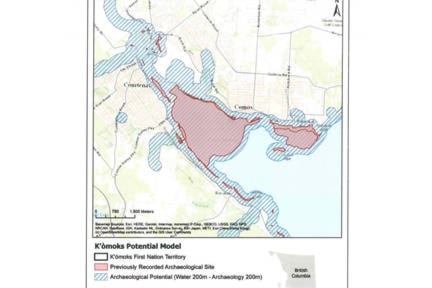The City of Courtenay is moving forward to work with the K’ómoks First Nation in order to implement their Cultural and Heritage Policy.
At the June 28 committee of the whole meeting, council unanimously approved a motion that will direct staff to work with KFN on the policy, which was presented at a community-to-community forum in November 2020.
The policy describes KFN’s specific standards and procedures for the management of archaeological sites in relation to development in KFN territory and the holder of a cultural heritage investigation permit (CHP) agrees to conduct work in adherence to those standards.
In a letter to council, KFN Chief Nicole Rempel noted until KFN has issued a permit for projects, it is to be understood that KFN has outstanding concerns about any potential project-related impacts on their cultural heritage.
“Moving forward, KFN expects that all levels of municipal government within KFN traditional territory … directly engage in the reconciliation process by formally acknowledging KFN’s CHP,” she added.
Geoff Garbutt, the city’s chief administrative officer told council he believes this is an opportunity to examine how the city can utilize the process with KFN to pre-plan and address archeological issues both known and unknown.
“At this time we do work with and advise private developers that they should consider these ideas because it’s really good practice and does guard against some really challenging things that could happen … I think it’s really important that we all collectively follow a similar procedure and at the same time it’s clear for implementation.”
He noted the four CAOs in the Valley (Courtenay, Comox, Cumberland and the Comox Valley Regional District) have been working with Todd Boychuk, K’ómoks director of intergovernmental relations on an effective and efficient process on the matter.
Coun. David Frisch inquired about the policy’s timeframe, which Garbutt noted a report would return to council mostly likely in late fall.
In terms of educating and/or advising a policy to the development community, Coun. Doug Hillian asked how a private developer would be made aware of the policy and the requirements for compliance.
“We raised this through known archaeological areas or private developers … in terms of holding them to account … there is provincial legislation that does that. Unfortunately, it is reactive. That’s why developers being aware of this and developing good practice and consulting with KFN is good practice,” he said.
Coun. Wendy Moran noted her son is an archeologist and warned there are many sites where the public and developers wouldn’t expect to find remains.
“ … I think particularly at this time when people are really grieving around unmarked graves we have to really, really take this seriously and we’re super cautious and try and get the message through to the development community and to those who may not have as much information on what a big deal this is.
“It’s a really difficult time right now - we have to be careful.”
The motion was passed unanimously.
photos@comoxvalleyrecord.com
Like us on Facebook and follow us on Twitter
